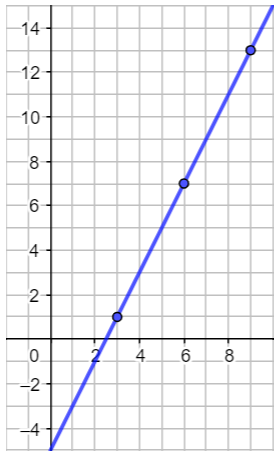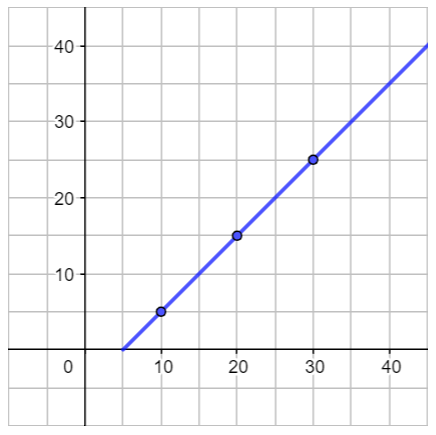Chapter 4 Represent And Solve Equations And Inequalities
Section 4.3: Write And Solve Addition And Subtraction Equations
Page 189 Exercise 1 Answer
An equation can be thought of as a pan – a pan is balanced when both sides weigh the same, similarly the equation is balanced, that is true, when both sides have the same value.
When the same weight is added or subtracted from both sides of the pan, the pan stays balanced. Similarly, when the same value is added or subtracted from both sides of the equation, the equation stays balanced, that is true – this is known as the Addition and Subtraction Properties of Equality.
Result
When the same weight is added or subtracted from both sides of the pan, the pan stays balanced. Similarly, when the same value is added or subtracted from both sides of the equation, the equation stays balanced, that is true – this is known as the Addition and Subtraction Properties of Equality.
Page 189 Exercise 1 Answer
Let n mark the number of students on the school bus before the last stop.
Since at the last stop 16 students boarded the bus, there were n + 16 students after the last stop. That is the left side of the equation.
The right side of the equation is 25, since the bus arrived at the school with 25 students.
Thus, the equation is
n + 16 = 25.
To find how many students were on the bus before the last stop use the equation and find the value of n.
n + 16 = 25
n = 25 – 16 (Subtract 16 from both sides of the equation.)
n = 9
Result
There were 9 students on the bus before the last stop.
Read And Learn More: enVisionmath 2.0 Grade 6 Volume 1 Solutions
Page 190 Exercise 1 Answer
To solve equations, we need to use inverse operations. To solve addition equations, we can then use subtraction to solve for the variable since addition and subtraction are inverses:
n + 12 = 16 Given equation.
n + 12 – 12 = 16 – 12 Subtract 12 on both sides.
n = 4 Simplify.
Cabrina then has 4 markers at the start.
Since 12 was subtracted on both sides of the equation, then the Subtraction Property of Equality was used to solve the equation. No other property could have been used since subtraction is the only inverse operation of addition.
Result
n + 12 = 16
n + 12 – 12 = 16 – 12
n = 4
Cabrina then has 4 markers at the start.
The Subtraction Property of Equality was used to solve the equation. No other property could have been used since subtraction is the only inverse operation of addition.
Page 191 Exercise 2 Answer
Both sides of the equation will represent how many pages she read. It is stated that she read 60 pages, so that will be one side of the equation. The other side will be p − 14 where p represents the number of pages she was assigned to read, and she read 14 pages fewer than she was assigned.
To find how many pages Vivian was assigned solve the equation – find the value of p which is the solution of the following equation.
p – 14 = 60
p – 14 + 14 = 60 + 14 (Use the Addition Property of Equality.)
p = 74
Vivian was assigned 74 pages to read.
Result
Vivian was assigned 74 pages to read.
Page 192 Exercise 1 Answer
To write an addition or subtraction equation, we determine which operation to use in the equation based on the given relationship. To solve the equation, we use an inverse operation to isolate the variable on one side of the equation. For an addition equation, the inverse operation is subtraction. For a subtraction equation, the inverse operation is addition.
Page 192 Exercise 2 Answer
To solve the equation n + 7 = 25 we need to find the value of n. To do this using the inverse relationship of addition and subtraction is to subtract 7 from both sides, since we need n on the left side, and everything else on the other.
That is, if n + 7 equals 25, then n + 7 − 7 must be equal to 25 − 7. Since n + 7 − 7 is n, then n = 25 − 7 = 18.
Result
Subtract 7 from both sides to get n on the left side and everything else on the other.
Page 192 Exercise 3 Answer
Both sides of the equation will represent how many book Clare had after she bought additional books. Since we know that is 24, that will be one side of the equation. However, we can think of that as t + 8 since she had t books and than bought 8 more books.
The equation is
24 = t + 8.
To find how many books she started with solve the equation – find the value of t. Use the Subtraction Property of Equality.
24 = t + 8
24 – 8 = t + 8 – 8 (Subtract 8 from both sides.)
16 = t
Clare started with 16 books.
Result
Clare started with 16 books.
Page 192 Exercise 4 Answer
Both sides of the equation will represent the outside temperature at the time Arianna ate dinner, t will represent the outside temperature when Arianna ate breakfast. When she ate dinner the temperature was 35°F – that will be one side of the equation. The other side will be t – 20° since the temperature dropped 20°F from the time she ate breakfast until the dinner.
To find the outside temperature when Arianna ate breakfast solve the equation – find the value of t. Use the Addition Property of Equality since when 20 is added we know the value of t.
35° = t – 20°
35° + 20 = t – 20° + 20 (Add 20 to both sides)
55° = t
The outside temperature at the time Arianna ate breakfast was 55°F.
Result
55°F
Page 192 Exercise 5 Answer
24 + m – 24 = 49 – 24 (Subtract 24 from both sides.)
m = 25 (Evaluate to find the value of m.)
Result
m = 25
Page 192 Exercise 6 Answer
12 + 11 = y – 11 + 11 (Add 11 to both sides.)
23 = y (Evaluate to find the value of y.)
Result
y = 23
Page 192 Exercise 7 Answer
22 – 13 = 13 + a – 13 (Subtract 13 from both sides.)
9 = a (Evaluate to find the value of a.)
Result
a = 9
Page 192 Exercise 8 Answer
t – 40 + 40 = 3 + 40 (Add 40 to both sides.)
t = 43 (Evaluate to find the value of t.)
Result
t = 43
Page 192 Exercise 9 Answer
d + 11 – 11 = 15 – 11 (Subtract 11 from both sides.)
d = 4 (Evaluate to find the value of d.)
Result
d = 4
Page 192 Exercise 10 Answer
32 + 19 = s – 19 + 19 (Add 19 to both sides.)
51 = s (Evaluate to find the value of s.)
Result
s = 51
Page 193 Exercise 11 Answer
y – 12 + 12 = 89 + 12 (Add 12 to the left side of the equation.)
y = 101 (Evaluate to find the value of y.)
Result
y = 101
Page 193 Exercise 12 Answer
80 + r – 80 = 160 – 80 (Subtract 80 from both sides.)
r = 80 (Evaluate to find the value of r.)
Result
r = 80
Page 193 Exercise 13 Answer
60 + 16 = x – 16 + 16 (Add 16 to both sides.)
76 = x (Evaluate to find the value of x.)
Result
x = 76
Page 193 Exercise 14 Answer
20 – 12 = y + 12 – 12 (Subtract 12 from both sides.)
8 = y
Result
y = 8
Page 193 Exercise 15 Answer
x + 2 − 2 = 19 − 2 (Subtract 2 from both sides.)
x = 17
Result
x = 17
Page 193 Exercise 16 Answer
z – 313 + 313 = 176 + 313 (Add 313 to both sides.)
z = 489 (Evaluate to find the value of z.)
Result
z = 489
Page 193 Exercise 17 Answer
Both sides of the equation will represent how many cards you have after the trade – that is one side of the equation is 9. The other side is t − 21, since you had t cards but you gave 21 cards to your friend.
The equation is
9 = t − 21.
To find how many cards were in the original deck, that is how many cards you had before the trade, solve the eqution – find the value of t. Use the Addition Property of Equality.
9 = t − 21
9 + 21 = t − 21 + 21
30 = t
There were 30 cards in the original deck.
Result
There were 30 cards in the original deck.
Page 193 Exercise 18 Answer
Both sides of the equation will represent the number of contacts Joy has in her phone list – one side of the equation is 100. If c represents the number of contacts she had in her phone list before she updated it, and we know 26 new contacts are added, the other side is c + 26.
The equation is
100 = c + 26.
To find the number of contacts Joy had in her phone list before she updated it solve the equation – find the value of c. Use the Subtraction Property of Equality.
100 = c + 26
100 – 26 = c + 26 – 26 (Subtract 26 from both sides.)
74 = c
Joy had 74 contacts in her phone list before she updated it.
Result
Joy had 74 contacts in her phone list before she updated it.
Page 193 Exercise 19 Answer
Both sides of the given equation show how much money Jeremy spent on a sandwwich and a drink. It is stated that he spent $7 and the price of the drink is known – $1.75. Solve the equation to find the cost of the sandwich he bought. Use the Subtraction Property of Equality.
7 = s + 1.75
7 – 1.75 = s + 1.75 – 1.75 (Subtract 1.75 from both sides.)
5.25 = s
The cost of Jeremy’s sandwich is $5.25.
Result
The cost of Jeremy’s sandwich is $5.25.
Page 194 Exercise 20 Answer
Solve the equation using the Subtraction Property of Equality.
42 + d = 51
42 + d – 42 = 51 – 42 (Subtract 42 from both sides.)
d = 9
The distance of the third leg of the race is 9 kilometers.
Result
d = 9
Page 194 Exercise 21 Answer
To solve the equation subtract 45 from both sides, that is use the Subtraction Property of Equality.
153 = g + 45
153 – 45 = g + 45 – 45 (Subtract 45 from both sides.)
108 = g
Result
g = 108
Page 194 Exercise 22 Answer
Use substitution to check if either of these values, y = 2,3,4, or 5, is the solution.
6 + 3y = 4y + 2
6 + 3(2) = 4(2) + 2
6 + 6 = 8 + 2
12 ≠ 10
6 + 3y = 4y + 2
6 + 3(3) = 4(3) + 2
6 + 9 = 12 + 2
15 ≠ 14
6 + 3y = 4y + 2
6 + 3(4) = 4(4) + 2
6 + 12 = 16 + 2
18 = 18
6 + 3y = 4y + 2
6 + 3(5) = 4(5) + 2
6 + 15 = 20 + 2
21 ≠ 22
The equation is balanced only if y = 4, thus that is the solution.
Result
y = 4
Page 194 Exercise 23 Answer
Both sides of the equation will represent the height of the helicopter after the descend which is equal to 477 – that is one side of the equation. The other side is the original height minus 127 meters for which it descended}$.
The equation which represents the problem is
477 = h − 127.
Solve the equation to find the original height of the helicopter.
477 = h − 127
477 + 127 = h − 127 + 127
604 = h
Result
477 = h − 127,h = 604.
Page 194 Exercise 24 Answer
In the three days of their annual production the drama club sold 826 tickets. Since on the first day they sold 143, on the second day 295, and on the third day t number of tickets, the sum of these numbers is 826.
Since 143 + 295 equals 438, the equation which represents the total amount of thickets sold is
438 + t = 826.
Solve the equation – find the value of t to answer the question. Use the Subtraction Property of Equality.
438 + t = 826
438 + t – 438 = 826 – 438 (Subtract 438 from both sides.)
t = 388
388 tickets were sold the third day.
Result
388 tickets were sold the third day.
Page 194 Exercise 25 Answer
Since there are 35 almonds, 34 hazelnuts, and 32 walnuts, the sum 35 + 34 + 32 represents the total number of almonds, hazelnuts, and walnuts.
35 + 34 + 32 = 101
Both sides of the equation will represent the total number of nuts – almonds, hazelnuts, walnuts, and pistachios. One side will thus be equal to 134. The other side is the sum of the total number of nuts – almonds, hazelnuts, walnuts, and pistachios. Since we have alread calculated the total number of almonds, hazelnuts, and walnuts, which is 101, the other side is equal to 101 + p, where p is the number of pistachios.
The equation is
134 = 101 + p.
Solve the equation – find the value of p to answer the question. Use the Subtraction Property of Equality.
134 = 101 + p
134 – 101 = 101 + p – 101 (Subtract 101 from both sides.)
33 = p
There are 33 pistachios in the bag.
Result
The total number of almonds, hazelnuts, and walnuts is 101. There are 33 pistachios in the bag.
Page 194 Exercise 26 Answer
To find which equations have g = 6 as the solution, substitute the variable with its value, that is substitute g with 6, and evaluate to see if the equation is balanced. If and only if the equation is balanced, g = 6 is the solution.
g + 2 = 10
6 + 2 = 10 (Substitute g with 6.)
8 ≠ 10 (Evaluate and compare.)
g – 1 = 10
6 – 1 = 10 (Substitute g with 6.)
5 ≠ 10 (Evaluate and compare.)
g – 2 = 4
6 – 2 = 4 (Substitute g with 6.)
4 = 4 (Evaluate and compare.)
58 + g = 60
58 + 6 = 60 (Substitute g with 6.)
64 ≠ 60 (Evaluate and compare.)
44 – g = 38
44 – 6 = 38 (Substitute g with 6.)
38 = 38 (Evaluate and compare.)
g = 6 the solution of equations: g − 2 = 4 and 44 − g = 38. g = 6 is not the solution of other equations since, when g is substituted with its value, the equations are not balanced.
Result
g − 2 = 4, 44 − g = 38.
Page 194 Exercise 27 Answer
To find which equations have x = 4 as the solution, substitute the variable with its value, that is substitute x with 4, and evaluate to see if the equation is balanced. If and only if the equation is balanced, x = 4 is the solution.
42 = 38 + x
42 = 38 + 4 (Substitute x with 4.)
42 = 42 (Evaluate and compare.)
x + 15 = 19
4 + 15 = 19 (Substitute x with 4.)
19 = 19 (Evaluate and compare.)
18 = x – 2
18 = 4 – 2 (Substitute x with 4.)
18 ≠ 2 (Evaluate and compare.)
36 = x + 32
36 = 4 + 32 (Substitute x with 4.)
36 = 36 (Evaluate and compare.)
52 – x = 46
52 – 4 = 46 (Substitute x with 4.)
48 ≠ 46 (Evaluate and compare.)
x = 4 is not the solution of other equations since, when x is substituted with its value, the equations are not balanced.
Result
42 = 38 + x, x + 15 = 19, and 36 = x + 32.


















































